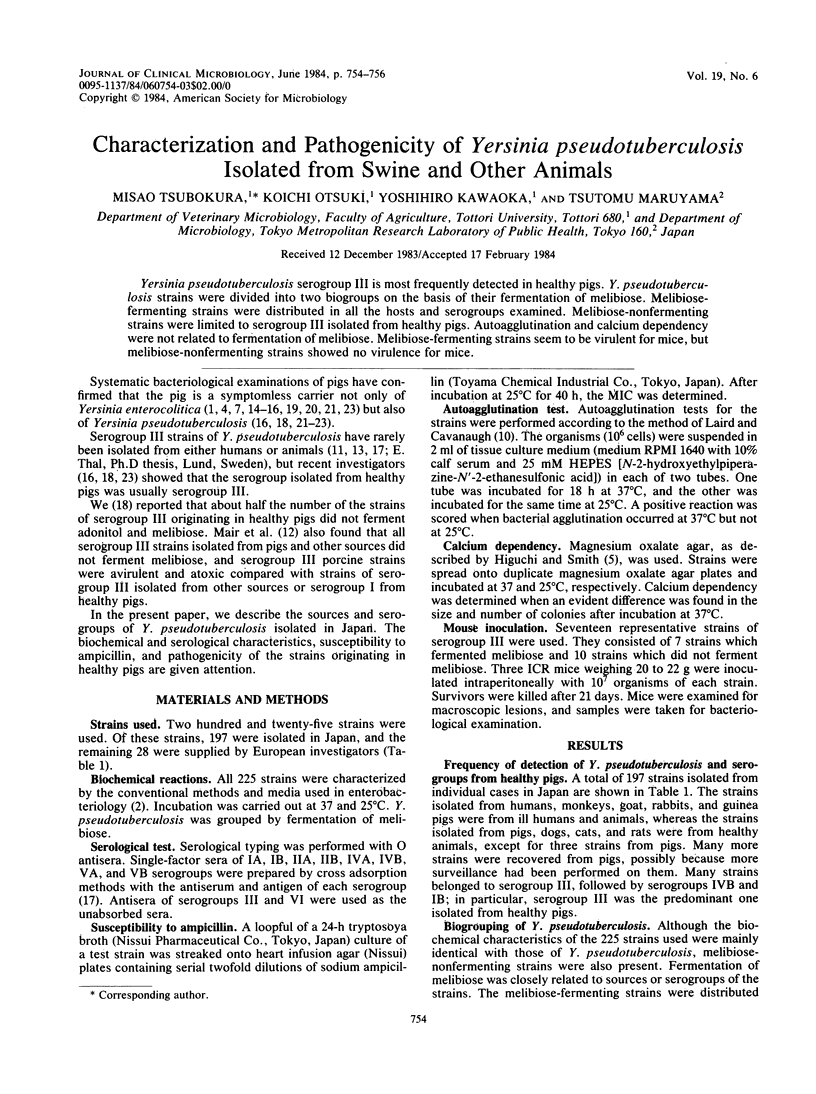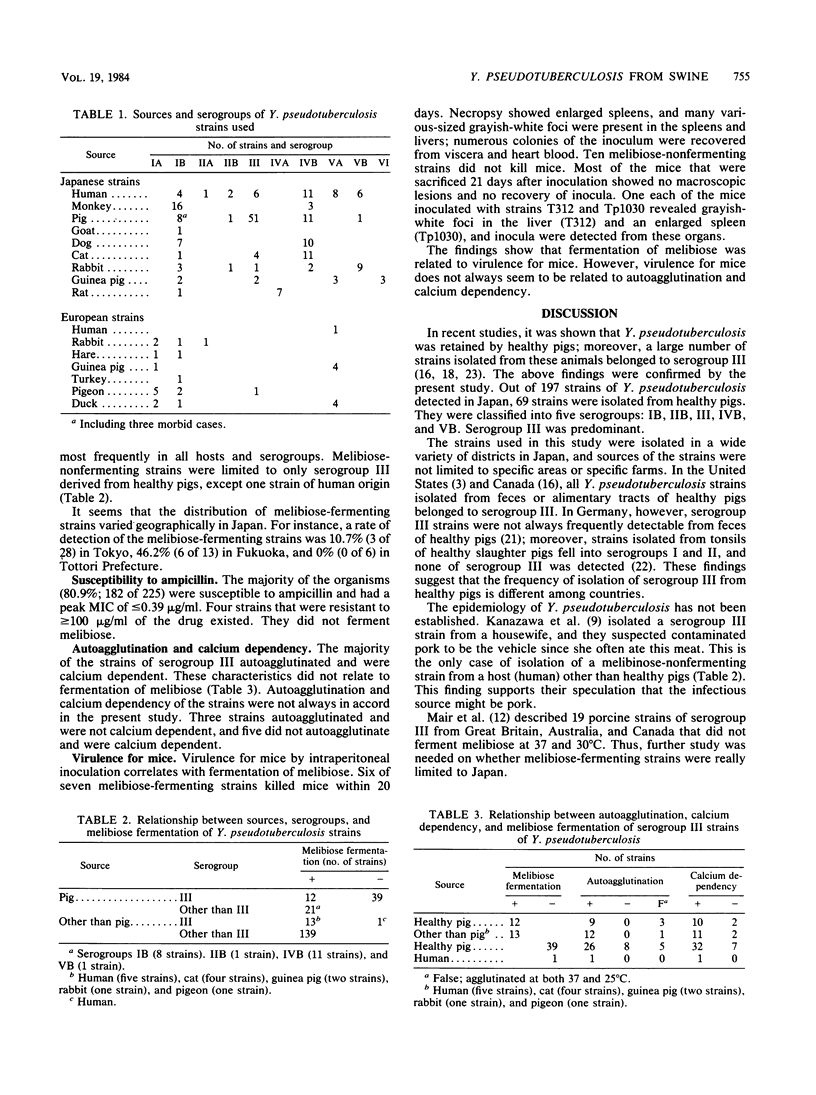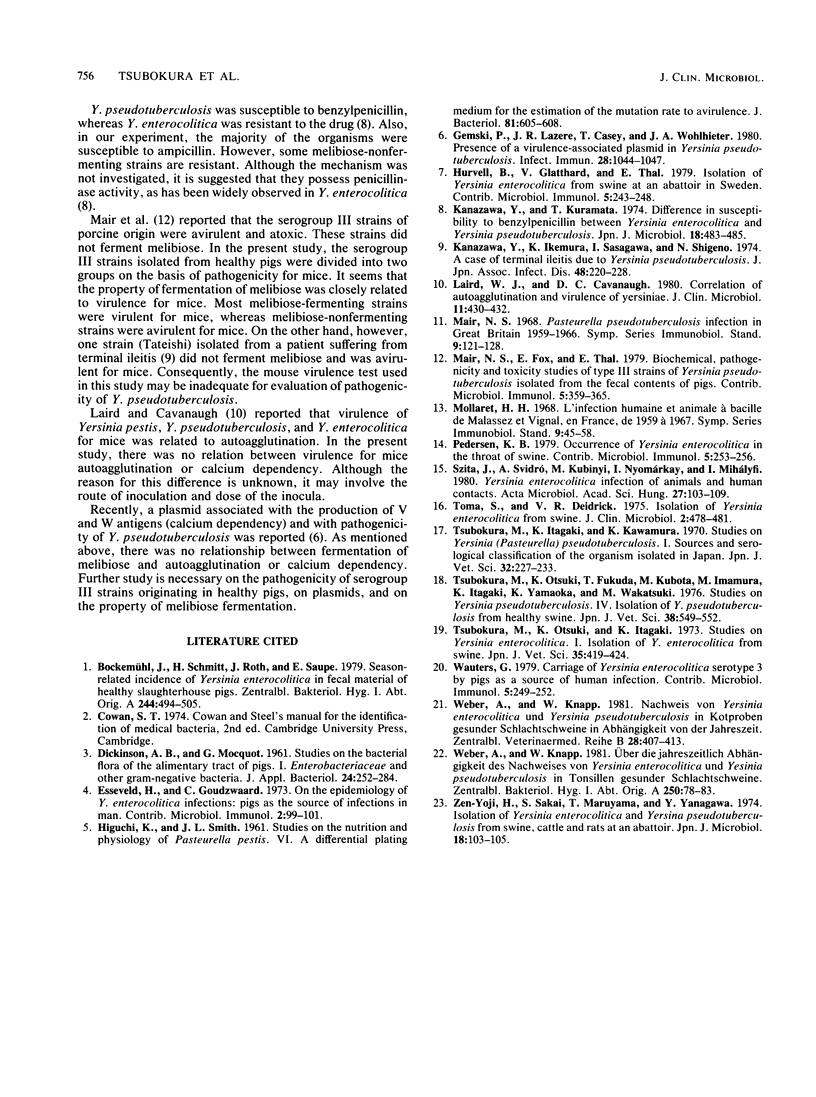Abstract
Yersinia pseudotuberculosis serogroup III is most frequently detected in healthy pigs. Y. pseudotuberculosis strains were divided into two biogroups on the basis of their fermentation of melibiose. Melibiose-fermenting strains were distributed in all the hosts and serogroups examined. Melibiose-nonfermenting strains were limited to serogroup III isolated from healthy pigs. Autoagglutination and calcium dependency were not related to fermentation of melibiose. Melibiose-fermenting strains seem to be virulent for mice, but melibiose-nonfermenting strains showed no virulence for mice.
Full text
PDF


Selected References
These references are in PubMed. This may not be the complete list of references from this article.
- Bockemühl J., Schmitt H., Roth J., Saupe E. Die jahreszeitliche Häufigkeit der Ausscheidung von Yersinia enterocolitica im Kot gesunder Schlachtschweine. Zentralbl Bakteriol Orig A. 1979 Sep;244(4):494–505. [PubMed] [Google Scholar]
- Gemski P., Lazere J. R., Casey T., Wohlhieter J. A. Presence of a virulence-associated plasmid in Yersinia pseudotuberculosis. Infect Immun. 1980 Jun;28(3):1044–1047. doi: 10.1128/iai.28.3.1044-1047.1980. [DOI] [PMC free article] [PubMed] [Google Scholar]
- HIGUCHI K., SMITH J. L. Studies on the nutrition and physiology of Pasteurella pestis. VI. A differential plating medium for the estimation of the mutation rate to avirulence. J Bacteriol. 1961 Apr;81:605–608. doi: 10.1128/jb.81.4.605-608.1961. [DOI] [PMC free article] [PubMed] [Google Scholar]
- Hurvell B., Glatthard V., Thal E. Isolation of Yersinia enterocolitica from swine at an abattoir in Sweden. Contrib Microbiol Immunol. 1979;5:243–248. [PubMed] [Google Scholar]
- Kanazawa Y., Ikemura K., Sasagawa I., Shigeno N. [Case of terminal ileitis due to Yersinia pseudotuberculosis]. Kansenshogaku Zasshi. 1974 Jun;48(6):220–228. doi: 10.11150/kansenshogakuzasshi1970.48.220. [DOI] [PubMed] [Google Scholar]
- Kanazawa Y., Kuramata T. Difference in susceptibility to benzylpenicillin between Yersinia enterocolitica and Yersinia pseudotuberculosis. Jpn J Microbiol. 1974 Nov;18(6):483–485. doi: 10.1111/j.1348-0421.1974.tb00839.x. [DOI] [PubMed] [Google Scholar]
- Laird W. J., Cavanaugh D. C. Correlation of autoagglutination and virulence of yersiniae. J Clin Microbiol. 1980 Apr;11(4):430–432. doi: 10.1128/jcm.11.4.430-432.1980. [DOI] [PMC free article] [PubMed] [Google Scholar]
- Mair N. S., Fox E., Thal E. Biochemical, pathogenicity and toxicity studies of type III strains of Yersinia pseudotuberculosis isolated from the cecal contents of pigs. Contrib Microbiol Immunol. 1979;5:359–365. [PubMed] [Google Scholar]
- Pedersen K. B. Occurrence of Yersinia enterocolitica in the throat of swine. Contrib Microbiol Immunol. 1979;5:253–256. [PubMed] [Google Scholar]
- Szita J., Svidró A., Kubinyi M., Nyomárkay I., Mihályfi I. Yersinia enterocolitica infection of animals and human contacts. Acta Microbiol Acad Sci Hung. 1980;27(2):103–109. [PubMed] [Google Scholar]
- Toma S., Deidrick V. R. Isolation of Yersinia enterocolitica from swine. J Clin Microbiol. 1975 Dec;2(6):478–481. doi: 10.1128/jcm.2.6.478-481.1975. [DOI] [PMC free article] [PubMed] [Google Scholar]
- Tsubokura M., Itagaki K., Kawamura K. Studies on Yersinia (Pasteurella) pseudotuberculosis. I. Sources and serological classification of the organism isolated in Japan. Nihon Juigaku Zasshi. 1970 Oct;32(5):227–233. doi: 10.1292/jvms1939.32.227. [DOI] [PubMed] [Google Scholar]
- Tsubokura M., Otsuki K., Fukuda T., Kubota M., Imamura M. Studies on Yersinia pseudotuberculosis. IV. Isolation of Y. pseudotuberculosis from healthy swine. Nihon Juigaku Zasshi. 1976 Dec;38(6):549–552. doi: 10.1292/jvms1939.38.549. [DOI] [PubMed] [Google Scholar]
- Tsubokura M., Otsuki K., Itagaki K. Studies on Yersinia enterocolitica. I. Isolation of Y. enterocolitica from swine. Nihon Juigaku Zasshi. 1973 Oct;35(5):419–424. doi: 10.1292/jvms1939.35.419. [DOI] [PubMed] [Google Scholar]
- Wauters G. Carriage of Yersinia enterocolitica serotype 3 by pigs as a source of human infection. Contrib Microbiol Immunol. 1979;5:249–252. [PubMed] [Google Scholar]
- Weber A., Knapp W. Nachweis von Yersinia enterocolitica und Yersinia pseudotuberculosis in Kotproben gesunder Schlachtschweine in Abhängigkeit von der Jahreszeit. Zentralbl Veterinarmed B. 1981;28(5):407–413. [PubMed] [Google Scholar]
- Weber A., Knapp W. Uber die jahreszeitliche Abhängigkeit des Nachweises von Yersinia enterocolitica und Yersinia pseudotuberculosis in Tonsillen gesunder Schlachtschweine. Zentralbl Bakteriol Mikrobiol Hyg A. 1981;250(1-2):78–83. [PubMed] [Google Scholar]
- Zen-Yoji H., Sakai S., Maruyama T., Yanagawa Y. Isolation of Yersinia enterocolitica and Yersinia pseudotuberculosis from swine, cattle and rats at an abattoir. Jpn J Microbiol. 1974 Jan;18(1):103–105. doi: 10.1111/j.1348-0421.1974.tb00753.x. [DOI] [PubMed] [Google Scholar]


